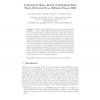Free Online Productivity Tools
i2Speak
i2Symbol
i2OCR
iTex2Img
iWeb2Print
iWeb2Shot
i2Type
iPdf2Split
iPdf2Merge
i2Bopomofo
i2Arabic
i2Style
i2Image
i2PDF
iLatex2Rtf
Sci2ools
103
Voted
MICCAI
2004
Springer
2004
Springer
A Statistical Shape Model of Individual Fiber Tracts Extracted from Diffusion Tensor MRI
Diffusion Tensor MRI has become the preferred imaging modality to explore white matter structure and brain connectivity in vivo. Conventional region of interest analysis and voxel-based comparison does not make use of the geometric properties of fiber tracts. This paper explores shape modelling of major fiber bundles. We describe tracts, represented as clustered sets of curves of similar shape, by a shape prototype swept along a space trajectory. This approach can naturally describe white matter structures observed either as bundles dispersing towards the cortex or tracts defined as dense patterns of parallel fibers. Sets of streamline curves obtained from tractography are clustered, parametrized and aligned with a similarity transform. An average curve and eigenmodes of shape variation describe a compact statistical shape model. Reconstruction by sweeping the template along the trajectory results in a simplified model of a tract. Feasibility is demonstrated by modelling callosal and c...
Related Content
| Added | 15 Nov 2009 |
| Updated | 15 Nov 2009 |
| Type | Conference |
| Year | 2004 |
| Where | MICCAI |
| Authors | Isabelle Corouge, Sylvain Gouttard, Guido Gerig |
Comments (0)

